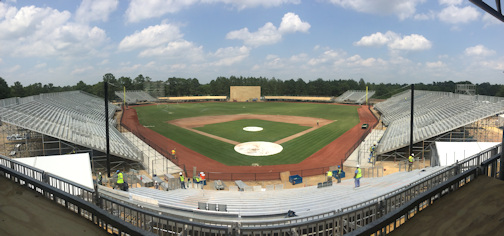This is part two of our series on the upcoming MLB game at Fort Bragg, NC
The Major League game between the Braves and Marlins on July 3 will be played at Fort Bragg, North Carolina, in a once-in-a-lifetime ballpark. Literally. That’s because the 12,500-capacity facility will be used only once. It will then be torn down, leaving only the playing field behind to be used by the recreation program for the service men and women and their families.
When Major League Baseball needed this unique facility designed, they went to the architects who are entirely or partially responsible for the majority of the big league parks in use today: Populous. For several reasons, this was no ordinary project for arguably the largest sports-architecture firm in the world. As a consequence, Populous didn’t rely on the team of architects in Kansas City that typically designs baseball stadiums. Instead, they turned to the firm’s Special Events Group.
“We’re actually serving as architects and event planners” for the upcoming game, explained Todd Barnes, a Principal at Populous. The relationship between Populous and MLB in event planning dates back to the 1999 All Star Game in Fenway, when the park’s cramped quarters caused the folks in MLB headquarters to question how they were going to pull off the Mid-Summer Classic there. Populous (back when it was called HOK) was called in to help.
Similarly, Populous worked with MLB on the All Star Game at Citi Field in 2013. For that, the firm’s Special Events Group “looked at all of the existing facilities and how to re-use different spaces for other All Star Game functions,” Barnes revealed. But since all of the facilities there were already in place, that makes the Fort Bragg project quite another story. “The difference with this project is that it’s a ground-up, design-and-build project, so we are the designer and architect on the project, as well as working on the event-planning side. Everything that’s being put in this ballpark right now is from the ground up. (And) it’s 100% temporary except for the playing field.”
You would think the one-time-use nature of the facility would make the design process radically different than Populous’ typical project, which is being built to last decades. Not so, says Barnes. Read More
